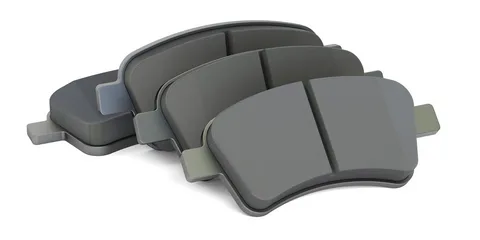
The global automotive brake pad market is projected to reach a valuation of USD 4.2 billion by 2032, up from an estimated USD 2.7 billion in 2022. The market is expected to grow at a steady compound annual growth rate (CAGR) of 4.6% from 2022 to 2032. Key drivers of this growth include increasing concerns about vehicle safety and ongoing technological advancements in the industry.
The automotive brake pad sector is experiencing significant expansion as manufacturers focus on making driving safer and more convenient by enhancing brake pad technology through technological innovations. Moving beyond traditional brake pads, manufacturers have integrated them into advanced systems such as anti-lock braking systems (ABS) and anti-collision technologies, creating a safer driving experience. Additionally, the growing demand for hybrid and electric vehicles, along with the adoption of regenerative braking and ABS, has been a dominant trend in the brake pad markets of the United States and Europe in recent years.
Moreover, defective brakes are a leading cause of accidents globally, making the development of innovative braking technologies and heightened safety concerns key factors driving demand for high-quality automotive brake components. This demand is particularly strong in developing countries where road safety is a significant concern. Although asbestos-based brake pads are expected to see a sharp decline in growth due to their harmful effects, such as the risk of lung cancer, other segments of the market are anticipated to contribute significantly to the overall growth of automotive brake pads during the forecast period.
Ready to make an informed decision? Contact our sales team to secure your copy of this report and stay ahead of the competition.
Key Takeaways:
- The North American automotive brake pad market will account for 41.4% of the global market share by 2032.
- The automotive brake pad market in the United States is expected to reach a value of US$ 451.3 Mn by 2032 due to the high demand for electric vehicles.
- China’s automotive brake pad market will expand at a CAGR of 3.6% and reach a value of US$ 84.3 Mn by 2032.
- By material type, the non-asbestos organic brake pad will generate high demand due to high toxicity of asbestos.
- The elevated demand for electric vehicles will propel the growth of the ceramic brake pads segment.
“High demand for safe, secure, and convenient driving experience and growing popularity of electric and hybrid vehicles will supplement the global growth of the automotive brake pad market over the forecast period,” – says an FMI analyst.
Competitive Landscape
Key market participants are entering new markets and establishing manufacturing facilities, as well as increasing investments in R&D activities. These players are also keen on product innovation and the development of brake pads that will have a greater shelf life. Joint ventures and strategic alliances are also employed to gain the upper hand in the competitive market.
Brembo S.p.A, Akebono Brake Company, Nisshinbo Brake Inc, Continental, Automotive GmbH, Bosch Limited, Tenneco Inc., Brakewel Automotive Components India Pvt. Ltd., among others, are some of the major players in the automotive brake pad market profiled in the full version of the report.
More Insights into Automotive Brake Pad Market Report
In its latest report, FMI offers an unbiased analysis of the global automotive brake pad market, providing historical data from 2017 to 2021 and forecast statistics for 2022 to 2032. To understand the global market potential, growth, and scope, the market is segmented on the basis of material type, vehicle type, and region.
The non-asbestos organic brake pad and ceramic brake pads are anticipated to observe high demand during 2022-2032. Since asbestos, as a material, is quite toxic, more and more manufacturers are opting for non-asbestos organic brake pads. Increasing use of ceramic brake pads in hybrid and electric vehicles will fuel the growth of this segment during 2022-2032.
Based on region, the North American automotive brake pad market will dominate the global marketplace with 41.4% of the overall market share. The growth of the regional market is mainly due to the presence of growth-inducing factors in the U.S. The technological advancements and an upsurge in the demand for electric vehicles will push the U.S. automotive brake pad market to grow at a CAGR of 3.9% during 2022-2032. China’s automotive brake pad market, too, will expand at a CAGR of 3.6% and reach a value of USD 282.2 Million by 2032.
Extensive Market Research: Complete Report and Findings
Key Segmentations
Automotive Brake Pad Market by Material type:
- Metallic Brake Pad
- Semi-Metallic Brake Pad,
- Ceramic Brake Pad
- Asbestos Brake Pad
- Non-Asbestos Organic Brake Pad
Automotive Brake Pad Market by Vehicle type:
- Commercial Vehicle
- Passenger Vehicle
Automotive Brake Pad Market by Region:
- North America Automotive Brake Pad Market
- Latin America Automotive Brake Pad Market
- Europe Automotive Brake Pad Market
- South Asia Automotive Brake Pad Market
- East Asia Automotive Brake Pad Market
- Oceania Automotive Brake Pad Market
- Middle East & Africa Automotive Brake Pad Market
About Future Market Insights (FMI)
Future Market Insights, Inc. (ESOMAR certified, recipient of the Stevie Award, and a member of the Greater New York Chamber of Commerce) offers profound insights into the driving factors that are boosting demand in the market. FMI stands as the leading global provider of market intelligence, advisory services, consulting, and events for the Packaging, Food and Beverage, Consumer Technology, Healthcare, Industrial, and Chemicals markets. With a vast team of 400 analysts worldwide, FMI provides global, regional, and local expertise on diverse domains and industry trends across more than 110 countries.
Contact Us:
Future Market Insights Inc.
Christiana Corporate, 200 Continental Drive,
Suite 401, Newark, Delaware – 19713, USA
T: +1-845-579-5705
For Sales Enquiries: sales@futuremarketinsights.com
Website: https://www.futuremarketinsights.com
LinkedIn| Twitter| Blogs | YouTube